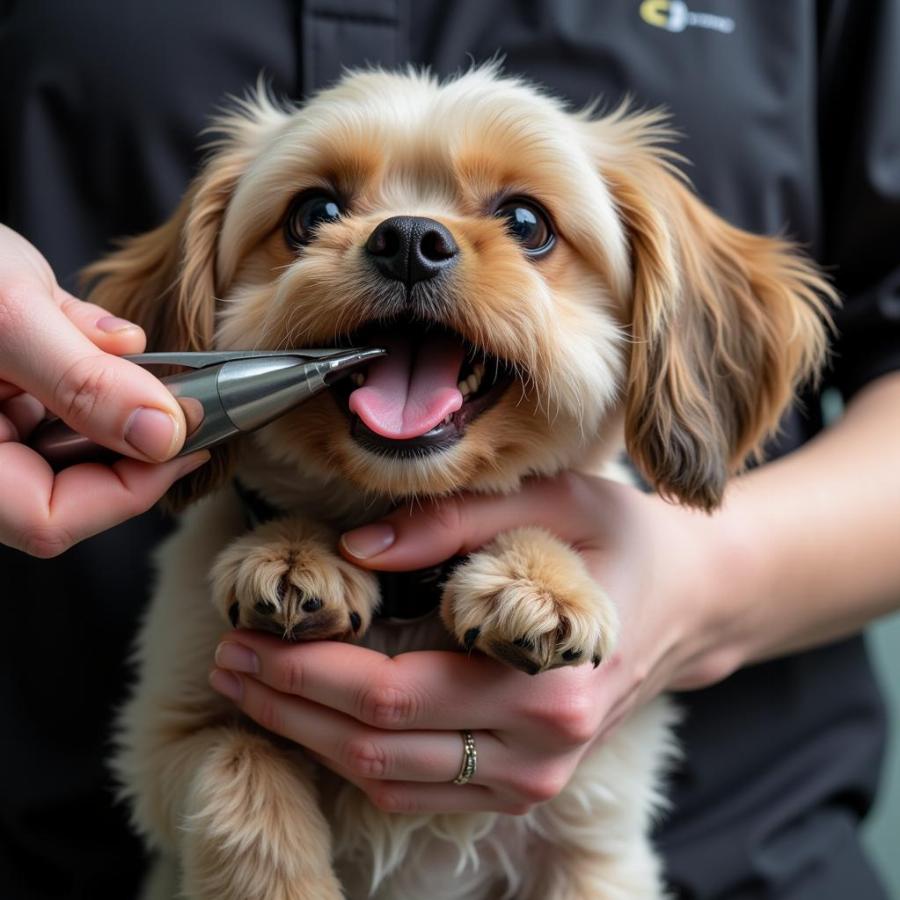A massive dog knot can be alarming, especially for first-time dog owners. While the term itself sounds intimidating, understanding what it means and how to address it is crucial for responsible pet ownership. This article delves into the intricacies of a massive dog knot, covering everything from prevention and management to the potential health concerns associated with it.
What Exactly is a Massive Dog Knot?
A massive dog knot typically refers to extensively matted fur, tightly tangled into a large, dense clump. These knots can occur in any dog breed with a long or double coat, but are especially common in breeds like Golden Retrievers, Cocker Spaniels, and Poodles. Neglecting regular grooming is the primary cause, allowing loose fur to intertwine and form increasingly larger knots. These knots can be painful for your dog, pulling on their skin and potentially hiding skin irritations or parasites.
What causes these massive knots? Primarily, lack of regular brushing. Dead fur doesn’t just disappear; it gets trapped in the healthy coat, creating tangles that grow over time. Other factors, such as rolling in dirt or burrs, can exacerbate the problem.
Preventing Massive Dog Knots: A Proactive Approach
Prevention is always better than cure, especially when it comes to massive dog knots. Regular brushing is the cornerstone of prevention. How often you brush depends on your dog’s breed and coat type, but a good rule of thumb is at least a few times a week. For breeds prone to matting, daily brushing is ideal.
What type of brush should you use? Slicker brushes are effective for removing loose fur and preventing tangles. For dogs with thick undercoats, de-shedding tools can be beneficial. Regular baths also help keep the coat clean and free of debris that can contribute to matting.
How to Deal with a Massive Dog Knot: Safe and Effective Methods
So, what if your dog already has a massive knot? The best approach depends on the severity of the matting. For small, superficial knots, you may be able to carefully work them out with a detangling spray and a comb. Start by gently separating the outer layers of the knot and work your way inwards. Never pull or yank, as this can cause pain and skin damage.
What if the knot is too large or tight to comb out? In these cases, it’s best to consult a professional groomer or veterinarian. They have the tools and expertise to safely remove the mat without causing your dog any harm. Trying to remove a large knot yourself can be risky and may accidentally cut your dog’s skin.
 Professional Groomer Removing Matted Fur from a Dog
Professional Groomer Removing Matted Fur from a Dog
Potential Health Concerns Associated with Massive Knots
Beyond the discomfort and pain, massive dog knots can lead to more serious health issues. Matted fur can trap moisture against the skin, creating a breeding ground for bacteria and fungi. This can lead to skin infections, hot spots, and even parasite infestations. Furthermore, severe matting can restrict blood flow to the skin, potentially causing tissue damage.
What are the signs of a skin infection under a mat? Look for redness, swelling, discharge, or a foul odor. If you notice any of these signs, take your dog to the veterinarian immediately.
Can Diet Influence Knot Formation?
While not a direct cause, a poor diet can contribute to a dull, dry coat that is more prone to matting. What should you feed your dog for a healthy coat? A balanced diet rich in essential fatty acids and proteins is crucial. Consult your veterinarian for recommendations tailored to your dog’s breed and age.
Conclusion: Prioritizing Your Dog’s Coat Health
Managing massive dog knots involves a combination of preventative measures and appropriate intervention. Regular grooming, a healthy diet, and prompt attention to matting are essential for ensuring your dog’s comfort and well-being. Remember, a well-maintained coat is not just about aesthetics; it’s a crucial indicator of your dog’s overall health. Don’t hesitate to seek professional help when needed. Your dog will thank you for it!
FAQs about Massive Dog Knots
- How often should I brush my dog? This depends on breed and coat type, but generally, at least a few times a week.
- What type of brush is best for preventing mats? Slicker brushes and de-shedding tools are effective.
- Can I cut out a mat myself? It’s best to consult a groomer or vet for large or tight mats.
- What are the signs of a skin infection under a mat? Redness, swelling, discharge, or a foul odor.
- Can diet affect coat health? Yes, a balanced diet is essential for a healthy, less mat-prone coat.
About Beaut Dogs
Beaut Dogs is your one-stop resource for all things related to dog care, offering expert advice and guidance on everything from breed selection to grooming and health. We are dedicated to providing reliable and up-to-date information to help you give your furry friend the best possible care. For any assistance or further questions, please contact us at [email protected]. We are always happy to help! You can visit our website at https://beautdogs.com.